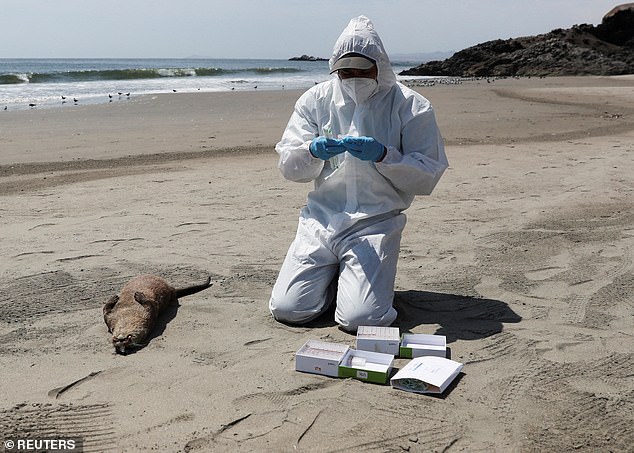Remnants of bird flu are found in grocery store milk – weeks after health officials assured public it wasn’t possible
- The FDA and CDC emphasize that milk on grocery store shelves is still safe to drink
- Bird flu has killed millions of birds, seals and livestock since 2022
- READ MORE: Americans are sounding out about fears that the BIRD FLU could come
Samples of pasteurized milk have tested positive for remnants of bird flu, which has already killed more than 90 million birds, thousands of seals and several cattle.
Government health officials insist that the traces of bird flu in milk are inactive and that the findings do not indicate that milk on supermarket shelves is unsafe.
While they insist there is no need for people to worry or throw away their milk, the escalating virus shows no signs of stopping, and the fact that it has infiltrated mammals is concerning to virologists.
Many people have described feeling “gaslit” by officials who insisted that America’s food supply was safe.
The FDA said it believes the virus particles discovered through extensive testing are leftovers from the pasteurization process that do not pose a threat.
Government health officials insist that the traces of bird flu in milk are inactive and that the findings do not indicate that milk on supermarket shelves is unsafe

The bird flu virus has killed about 17,400 seal pups in a single colony in the US. The virus’s ability to pass from birds to mammals has some virologists concerned
The FDA said: ‘Pasteurization is a process that kills harmful bacteria and viruses by heating milk to a specific temperature for a specified period of time to make milk safer.
‘Even if the virus is found in raw milk, pasteurization is generally expected to eliminate pathogens to a level that does not pose a risk to consumer health.’
The agency added: “To date, we have seen nothing that would change our assessment that the commercial milk supply is safe.”
Details, such as which brands of milk were found to contain virus residues, were not provided.
In addition to infecting birds, seals, livestock and cats, the bird flu virus also infected a farm worker in Texas.
The farmer’s H5N1 sample showed it had a mutation “known to be associated with viral adaptation to mammalian hosts” — but federal health agencies insisted the mutations were minor and the overall risk to the public was low.
This mutation was not detected in cattle or wild birds, and officials said the mutation may have been acquired through an eye infection.
Bird flu has gripped the animal world since 2020, resulting in a massive slaughter of poultry and other birds.
It is believed to be migrating infected seabirds passed through Greenland and reached the US from Europe.
Others say the birds likely carried the virus when it crossed the Atlantic Ocean and landed in Newfoundland to breed.
The FDA’s announcement comes amid growing concerns about outbreaks among dairy cows, which have resulted in restrictions on livestock imports from states where bird flu has been diagnosed.
Several states, including New York, have also warned residents to keep their distance from local wildlife such as geese, falcons and hawks, which can carry the deadly virus.
Meanwhile, states like Iowa, California and Minnesota have started testing their animals for the virus.
Infected cattle are described as ‘sleepy’, eating less food and producing less milk.
Cows can become infected by bird droppings in their pastures where the animals congregate and graze.
So far, 28 farms in eight states have reported H5N1 infections in their cows, including 11 in Texas and six in New Mexico.
